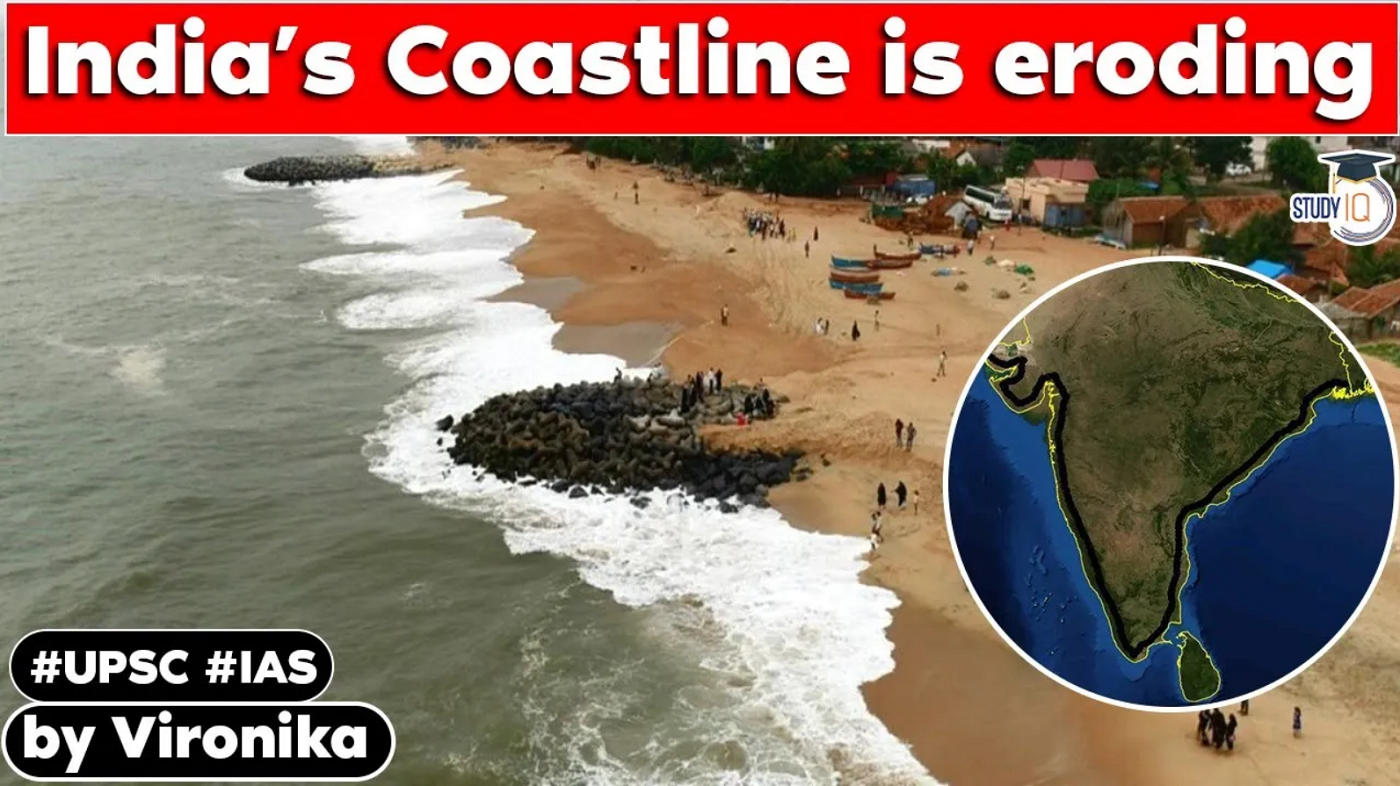Table of Contents

- The Ministry of Earth Sciences, in a response to a question, informed the Lok Sabha earlier this week that of the 6,907.18 km long Indian coastline of the mainland, about 34% is under varying degrees of erosion, while 26% is of the coastline is of an accreting nature, and the remaining 40% is in a stable state.

- “The National Centre for Coastal Research (NCCR), Chennai, an attached office of the Ministry of Earth Sciences (MoES) is monitoring shoreline erosion since 1990 using remote sensing data and GIS mapping techniques. About 6,907.18 km long Indian coastline of mainland has been analysed from 1990 to 2018,”
- the Ministry said in response to a question from Bharatiya Janata Party (BJP) MP from Bhubaneswar, Aparajita Sarangi, on April 6.
Key Highlights
- In terms of percentage, West Bengal, with a 35 km-long coastline, suffered erosion along about 60.5% of the coast (323.07 km) over the period from 1990 to 2018.
- This is followed by Kerala on the west coast, which has 96 km of coastline and 46.4% of it (275.33 km) faced erosion.

- Another organisation under the MoES, the Indian National Centre for Ocean Information Services (INCOIS), has prepared and published an atlas of Coastal Vulnerability Index (CVI) maps for the entire coastline of India at a 1:100000 scale using data on sea level rise, coastal slope, shoreline change rate, coastal elevation, coastal geomorphology, tidal range and significant wave height, the Ministry informed the Parliament.
- A report on ‘National Assessment of Shoreline Changes along Indian Coast’ was released in July, 2018 and shared with various Central and State government Agencies and Stakeholders for implementing shore line protection measures.
- The digital and hard copy of all the Maps is released on 25th March, 2022. Ministry through its institutes is also providing technical solutions and advice to the State Governments and UTs [Union Territories] to deal with coastal erosion threats.
What is Coastal Erosion?
- Coastal erosion is the process by which local sea level rise, strong wave action, and coastal flooding wear down or carry away rocks, soils, and/or sands along the coast.
- There are four main processes of coastal erosion. These are corrasion, abrasion, hydraulic action and attrition.
Causes of Coastal Erosion
- Wave energy is considered to be the primary reason for coastal erosion.
- Natural hazards like cyclones, thermal expansion of seawater, storm surges, tsunami etc due to the melting of continental glaciers and ice sheets as a result of climate change hamper the natural rhythm and precipitate erosion.
- Strong littoral drift resulting in sand movement can also be considered as one of the major reasons for coastal erosion.
- Dredging, sand mining and coral mining have contributed to coastal erosion causing sediment deficit, modification of water depth leading to longshore drift and altered wave refraction.
- Coastal erosion has been sparked by fishing harbours and dams constructed in the catchment area of rivers and ports reducing the flow of sediments from river estuaries.
- Heavy rainfall can enhance the saturation of soils, with high saturation leading to a reduction in the soil’s shear strength, and a corresponding increase in the chance of slope failure (landslides).
Impacts of Coastal Erosion
- Loss of habitat/ beach and landscape quality.
- Loss of buildings, infrastructure facilities such as roads and power lines.
- Degradation of coral reefs due to deposition of silt.
- Reduce the tolerance to face natural hazards such as Tsunamis
- Increased turbidity of water.
- Reduce the sand volume to compensate the natural littoral processes,
- Reduce scenic beauty of the beach
- Collapse the tourism in the area.
- Loss of boat anchorage sites.
- Increase the frequency of flooding in the lowland areas.
- Increase the wave energy on beaches endangering local people.
- Decrease water quality.
- Reduction of coral reef sites.
- Reduce primary production and fish productivity.
- Considerable annual expenditure for damage mitigation, control and disaster relief.
- Marine and associated ecosystems are made more fragile.
Policy on displacement
- The XVth Finance Commission had recommended the creation of a National Disaster Risk Management Fund (NDRMF) and State Disaster Risk Management Fund (SDRMF) comprising a Mitigation Fund at the National and State-levels (NDMF/SDMF), and a Response Fund at the National and State level (NDRF/SDRF) for the award period from 2021-22 to 2022-26.

- The Commission has also made specific recommendations for ‘Mitigation Measures to Prevent Erosion’ under NDMF and ‘Resettlement of Displaced People Affected by Erosion’ under NDRF.
Question:
Which of these coastal landforms is created by erosion?
- Cave
- Spit
- Beach
- Tombolo
Latest Burning Issues | Free PDF
























 WhatsApp
WhatsApp